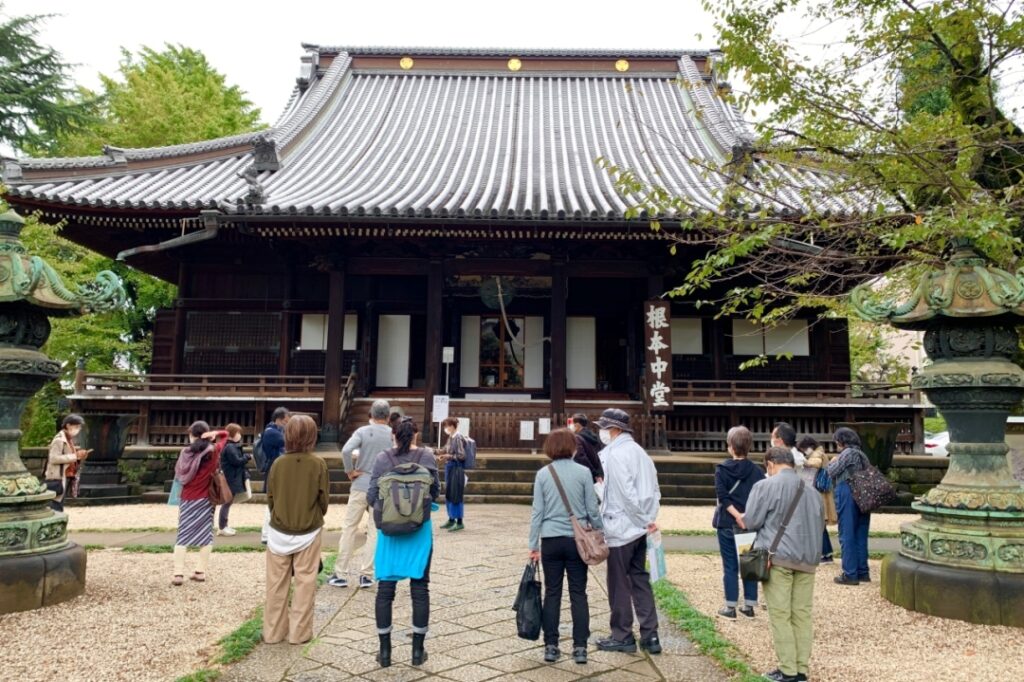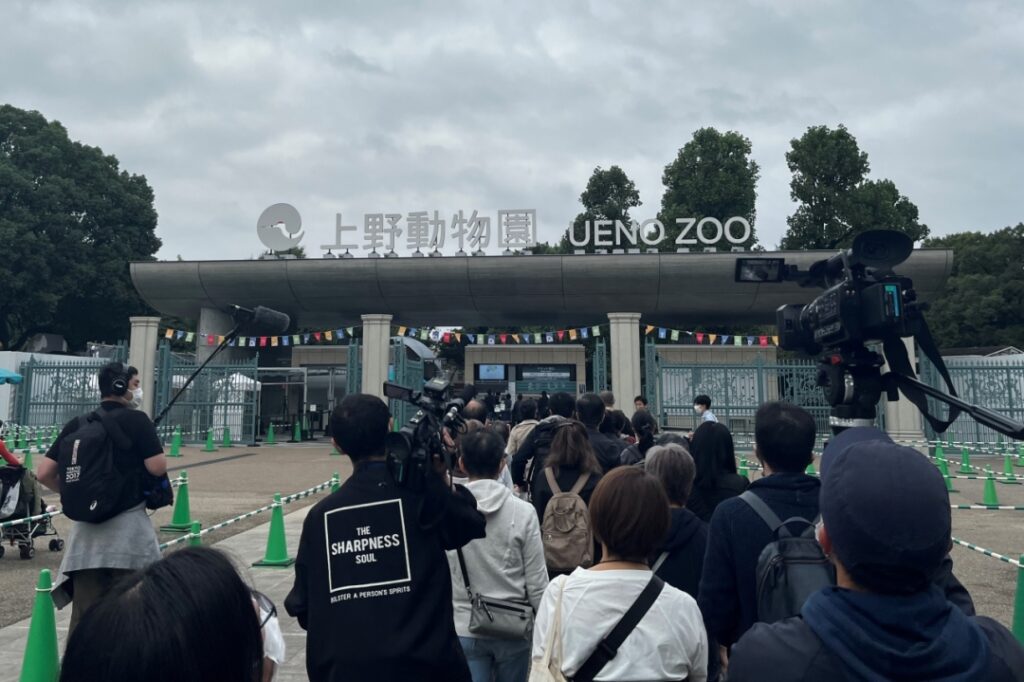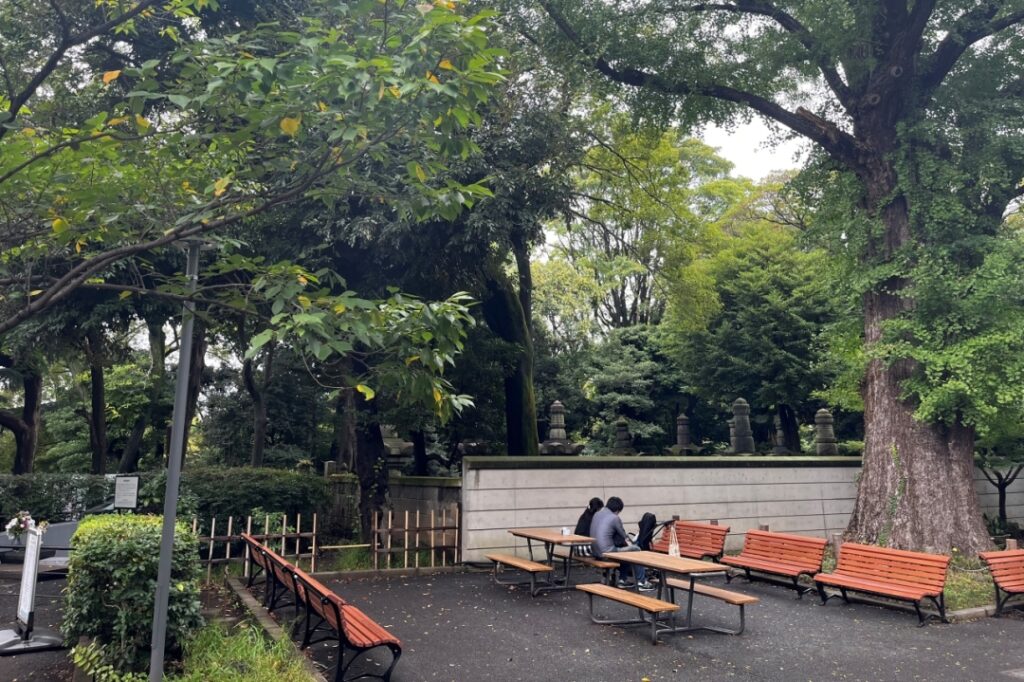
Opened in 1873 (Meiji 6) on a plateau called “Ueno Mountain”, it is Japan’s oldest park, and Ueno Onshi Park ( hereinafter referred to as Ueno Park) .
Known as one of Japan’s leading cherry blossom viewing spots, it is a popular spot visited by many tourists from Japan and abroad . Do you know
On October 14, 2022, a tour event called “Kaneiji Monks and Kaneiji Monks” will be held, where Kaneiji monks will personally guide you through Ueno Park, which is still dotted with various temples related to Kaneiji, such as Kiyomizu Kannondo and the five-storied pagoda. Walking around Ueno Park” was held, so I will report on the situation on the day.
20 lucky people gather at Kan’eiji’s Konponchudo!

The “Ueno Park Tour with Kan’eiji Monks” has been held as part of the “Ueno Mountain Cultural Zone Festival ,” which holds numerous arts and cultural events in the mountains of Ueno every fall. Participation is free of charge, and every year it is a popular event with a winning multiplier of more than 10 times.
Unfortunately, it was cloudy that day, but it was a pleasant weather with a maximum temperature of about 20 degrees, making it a perfect day for a walk.

The meeting place is Konponchudo , the main hall of Kaneiji Temple, which is adjacent to the north side of Ueno Park. The guide was Mr. Ryogaku Ishikawa , a butler of Kan’eiji Temple’s teaching department (a department like the public relations department that conveys the Buddha’s teachings to people).

Kan’ei-ji Temple is named after the era name “Kanei” when it was founded. In 1625 (Kanei 2nd year), Tendai priest, who was a priest of the Tendai sect to which the three generations of Tokugawa Ieyasu, Hidetada, and Iemitsu devoted themselves, was deeply involved in the construction of the castle town of Edo. It was erected on the mountain of Ueno, which is located in the northeast.
Originally, it was a prayer temple to pray for the peace of the Tokugawa Shogunate and the peace of all people.
Ueno’s Kan’eiji Temple is called ‘Toeizan’, which means ‘Eastern Hieizan’ . It is said that the temple grounds and layout of Kan’ei-ji Temple at that time resembled Enryaku-ji Temple on Mt.
(Kiyomizu Kannon-do is likened to Kyoto’s Kiyomizu-dera Temple, Shinobazu Pond Bentendo is likened to Lake Biwa and the Benzaiten-do Hall of Hogonji Temple on Chikubu Island, etc.)

In the Edo period, Kan’ei-ji Temple boasted an area that was about twice the size of today’s Ueno Park, and had 36 temples built with donations from feudal lords. Buildings were burned down one after another during the Ueno War (Boshin War) . Furthermore, he was thought to have harbored the Shogitai, and suffered the misfortune of having all of the precincts confiscated.
Later, only about 10% of the land that survived the war was returned, and it is said that the precincts of Kan’eiji Temple became an enclave as it is today. The confiscated land was developed as a park in the early Meiji period.
Hmmm, so it was a temple with a pretty spectacular history… As someone who regularly enjoys Ueno Park’s cultural facilities, I can’t say for sure, but 1/10 is just too bad!
After listening to this story, I will walk with the participants from Konponchudo to Ueno Park.
Tenkai Daiso was a key figure in making Mt. Ueno a famous spot for cherry blossoms.
I thought that the course would proceed in the form of a commentary when we arrived at a place related to Kan’eiji, but Mr. Ishikawa would like to show us various interesting episodes related to Kan’eiji and Ueno Park while on the move. I was.

For example, why are there so many cultural facilities and educational institutions that Ueno is called the “Forest of Culture”?
The new Meiji government originally planned to build the University East Campus (the predecessor of the University of Tokyo School of Medicine) on the confiscated land, which had been destroyed by fire and was a very convenient place to build a town from scratch. However, Dr. Bauduin, a Dutch military doctor who visited Ueno for inspection, was afraid that Ueno’s nature would be lost, and suggested that it should be made into a park.
As a result, Japan’s first park was completed in 1873. It was used as a place to appeal the civilization and enlightenment led by the new Meiji government, and cultural facilities such as museums and art galleries were born one after another, and it was also the stage for numerous expositions.

Also, the story of the cherry blossoms, which is a specialty of Ueno Park, came out.
When did cherry blossoms come to the mountains of Ueno? Mr. Ishikawa says that it was around 400 years ago when Kan’eiji Temple was built.
Kan’ei-ji was opened as a prayer temple, but Tenkai Daiso aimed to make it a temple that not only people related to the Tokugawa family, but also the common people could visit, and started to make it attractive as a tourist spot. rice field. The most prominent of these is the cherry blossoms, and the high priest Amami brought many wild cherry blossoms from the mountains of Yoshino and planted them in the precincts of Kan’eiji Temple. It is said that it is connected to today’s row of cherry blossom trees in Ueno Park.
In the old days, cherry blossom viewing meant viewing plum blossoms, but it is said that the culture of viewing cherry blossoms during cherry blossom viewing gradually spread as a result of events such as “Daigo Hanami” held at Daigoji Temple in Kyoto by Toyotomi Hideyoshi. . Over time, Ueno’s mountains have become the best cherry blossom viewing spot in Edo and are visited by many tourists.
Back then, unlike today, cherry blossom viewing at night was restricted. Mr. Ishikawa says with a smile that there is still an anecdote that he was sarcastically told, “Only monks can enjoy the cherry blossoms at night.”
Although it was a fairly long two-hour walk, I lost track of time listening to Mr. Ishikawa’s humorous narration, which gave us new bits of knowledge one after another.
The Konpon Chudo in the Edo period was as big as the Tokyo National Museum! ?

The first place I visited in Ueno Park was the fountain plaza , a space for relaxation. I can’t find any buildings that seem to be related to Kan’eiji Temple, but…?
Actually, Konponchudo was originally built around this fountain square. The Konponchu-do Hall, which was just a moment ago, was relocated and rebuilt after the Meiji Restoration.
You can see the big main building of the Tokyo National Museum in the back, but it seems that the Konpon Chudo Hall used to be about the size of that main building. There is even testimony that it burned for three days and three nights when it was set on fire.
The next place I visited was the relief that was installed just behind the coffee shop.

This relief is based on Utagawa Hiroshige’s “Touto Meisho Ueno Toeizan Complete Map”, which depicts the precincts of the former Kan’eiji Temple. The large building on the left is Konponchudo. You can feel the vastness of the precincts of the past.

If you look closely, you can see “bamboo shaped like broccoli” (by Mr. Ishikawa) drawn on both sides of the Konponchudo. Jikaku Daishi Ennin, a disciple of Saicho, brought bamboo from Mt. It is said to have been planted.
It is still planted in front of Konponchudo, so it would be interesting to look for it when visiting the shrine.
The graveyard of the Todo family, which stands quietly in the zoo

Next, we headed to Ueno Zoo. We will proceed to the middle while being watched by the customers who are waiting in line to see the pandas.
The destination was a cemetery where Takatora Todo the first and the Todo family rested, which is usually surrounded by a fence that people cannot enter. There’s a grave in a place like this…! ?
(The shooting inside was NG)

Mr. Ishikawa emphasized the degree of rarity, saying, “This is the only time a year when we can guide the general public!” It seems that many of the participants were more or less familiar with the history of Ueno, just because they had applied for this event. It’s how it is.
There were 14 stone pagodas that were almost 3 meters high, and it was a strange sight in a way, but it was also a very calming space where only the rustling of trees and the singing of birds could be heard.
The feudal lord Todo Takatora, who was known as a master of castle construction, was especially important among Ieyasu’s aides. He donated the land where the Todo family’s suburban residence was located for the construction of Ueno’s Toshogu Shrine (at the time, it was Toshosha, one of the temples of Kan’eiji Temple) in which Ieyasu was enshrined. Kansho-in was built on the ruins of the mansion as a separate temple of Toshogu.
The place where Kanshoin used to be is now replaced by Ueno Zoo, but only the cemetery remains as it is.
Mr. Ishikawa mentioned the scene right before Ieyasu’s death as his favorite Takatora episode.
Ieyasu believed in the Tendai sect, but worried that Takatora, whom he trusted, was not of the Tendai sect. Upon hearing this, Takatora was so moved that he asked Tenkai Daisojo, who was present, to change his sect to the Tendai sect.
Todo Takatora had an image of a renegade man who kept changing his lord, but he was a loyal man who was devoted to the Tokugawa family.
Caption: Ueno Zoo also has a five-storied pagoda to enshrine the remains of Buddha. Since Kan’eiji Temple cannot manage it directly, it has been handed over to the Tokyo Metropolitan Government for protection.
Very popular with students! The unfortunate episode of Ueno Daibutsu
If you leave Ueno Zoo and walk towards Sakura-dori, you will see the Ueno Great Buddha and pagoda on the hill near Ueno Seiyoken.

If you don’t have any prior knowledge, you may wonder, “What is this that enshrines only the face?”
The Great Buddha of Ueno began in 1631 when Naoyori Hori, the feudal lord of the Echigo Murakami domain, erected a seated statue of Shaka Nyorai with plaster for those who had fallen in the war. Around 1655 to 1660, it was changed to an 8-meter-tall copper Buddha statue, and although it was repeatedly damaged and rebuilt, it is said that its face finally fell off during the Great Kanto Earthquake. Although he tried to fix it, the torso was requisitioned by the military during World War II.
After the war, even the face kept by Kan’eiji Temple was enshrined on the site of the Daibutsuden until today.
Today, many students come to pray for passing exams as a great Buddha that does not fall down, saying, “I don’t have a body anymore, so I won’t fall down.” It is a rare spot in Japan where you can stroke the face of the Great Buddha.


When I got off the hill where Ueno Daibutsu is located, I could see the Toki no Kane (Time Bell Hall) in the distance. Basho Matsuo is famous for his haiku, “Hana no Kumo, the bell is Ueno or Asakusa?”
According to Mr. Ishikawa, this bell, which was active as a time signal in the Edo period, still rings three times a day, at 6:00 in the morning and at noon.
*The current Toki no Kane was recast in 1787.
“Tsuki no Matsu” is a photo spot where you can feel the elegance of the Edo period
After bowing to the Great Buddha, the group walks further along Sakura-dori to the stage of Kiyomizu Kannondo .

Looking towards Shinobazu Pond from the stage, you can see “Moon Pine”, a pine branch grown in a circle, which is known to have been drawn by Utagawa Hiroshige in “One Hundred Famous Views of Edo”. It was destroyed by a typhoon in the Meiji period and was revived in 2012 after 150 years.

Surprisingly, according to Mr. Ishikawa, the “Tsuki no Matsu” did not exist when Kan’eiji was founded. It seems that the specific year of production is not known, but “A peaceful era continued, and around 1800, people’s lives became relaxed and playful, and one of them appeared in this “ Tsuki no Matsu ”. I wonder if there is.”
An elegant landscape overlooking Shinobazu Pond and Bentendo in a circle. Mr. Ishikawa, who said that this is the most beautiful spot, recommended it to all the participants, and we entered the photo time. It was a pity that it was cloudy on this occasion, but I will try again on a sunny day in the future!

After this, we took a short break for about 10 minutes in Kiyomizu Kannondo, where the contrast between vermillion, black, and gold is beautiful.
By the way, Kiyomizu Kannondo, a hall modeled after Kyoto’s Kiyomizu Temple, was built in 1631 (Kanei 8) on Mt. It was relocated to its current location in Genroku 7. It is said to be one of the few halls of Kan’eiji that suffered almost no damage during the war.
When it was relocated, instead of building a new building, the wood was taken apart, so even now, more than 300 years after its construction, the wood used is still the same as it was at that time.
The principal object of worship is the statue of Senju Kannon, which was transferred from Kiyomizu-dera Temple. On the left and right, following Kiyomizu-dera Temple, the attendant Katsugun Jizo (Jizo Bosatsu) and Bishamonten Buddha statues are placed. The theory is that it is a basusen, and it is quite rare to see a Katsugun Jizo wearing armor.
The place where you can see the actual Katsugun Jizo itself is valuable, so Mr. Ishikawa said, “Please tell your friends who are history buffs about it.”
The tragedy that occurred at Kan’eiji Temple, the grave of the Shogitai that conveys the tragedy of war
At the end of the walk, we visited the grave of Shogitai .

In 1868 (Keio 4), the bloodless surrender of Edo Castle caused the 15th shogun Yoshinobu, who had been placed under confinement at Kan’eiji Temple, to leave for his hometown of Mito, but his aides and ronin volunteers were there to protect Yoshinobu. The Shogitai, which was formed by, remains stationary in Ueno. Before long, the new government army will be watching.
As a result, the Ueno War broke out involving Kan’eiji Temple, which was the base of the Shogitai. It is said that the victims of the Shogitai were not only defeated in battle, but also treated dishonorably as national bandits.

After that, a monk who hid his identity cremated the bodies of 266 people and buried them in Entsuji Temple in Arakawa Ward, but for a long time it was not possible to officially memorialize them. Finally, around 1881 (Meiji 14), a memorial monument was erected at the site of the fierce battle. That is the grave of the Shogitai.
By the way, in front of the Shogitai Grave, there is a bronze statue of Takamori Saigo, who was a central figure in the new government army, but he is standing with his buttocks facing the grave. It makes me wonder, “What was your intention?”

Mr. Ishikawa, summarizing this tragedy, said, “It can’t be helped because it was that kind of era, but as a modern person, I think it’s too much.” As the words of the monk of Kan’eiji Temple in Ueno, which became the only battlefield in Edo during the Boshin War, these words strike me deeply.
It seems that we need to remember that the education and art that we enjoy today at the cultural facilities in Ueno Park are based on the unreasonableness of war. After attending this event, I felt that my view of Ueno Park changed a little.

It was an interview report on “Walking around Ueno Park with the monks of Kaneiji Temple”.
The volume of the event was unbelievable for a two-hour event, and I was able to hear many times more interesting stories from Mr. Ishikawa than I have introduced here!
Everyone who participated did not look tired, and everyone had an aura of great satisfaction. It was impressive that people with companions exchanged their impressions.
It will be held as part of the “Ueno Mountain Culture Zone Festival” from next year, so if you are interested, please apply.
*Since the opening and closing times of each facility in Yamauchi are different, please check the website of Kaneiji Temple when visiting.


